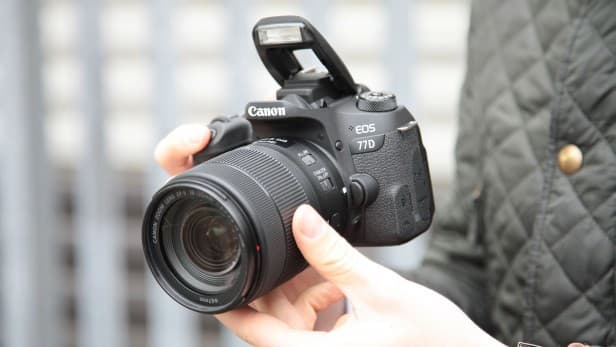What is the Canon EOS 77D?
A couple of years ago, Canon added two similar models to its EOS line-up in the form of the EOS 750D and EOS 760D. At the time, we questioned the manufacturer’s rationale behind creating two cameras with near-identical specifications.
Two years on, we’re presented with another pair of similar EOS models. The new EOS 800D replaces the EOS 750D and is targeted at newcomers to DSLRs, such as those stepping up from a basic compact or a smartphone. The EOS 77D on test here is the EOS 760D’s successor, and sets out to appeal to aspiring enthusiasts with greater photographic knowledge who are after sophisticated control.
Find more great Canon DSLRs in our guide to the best Canon EOS DSLRs you can buy!
Canon EOS 77D – Features
Just like the EOS 80D that’s positioned above it in Canon’s enthusiast line-up, the EOS 77D is equipped with a 24.2MP APS-C CMOS sensor. Although this sensor doesn’t offer a higher pixel count like the EOS 760D did over the older EOS 700D, it does support Canon’s Dual Pixel AF technology that promises considerably faster focus acquisition in live view.
As well as this notable enhancement, the EOS 77D’s sensor pairs up with Canon’s most up-to-date DIGIC 7 image processor that’s claimed to process data 14x faster than the DIGIC 6 processor found within the EOS 750D/760D. This has resulted in the camera offering a higher maximum burst speed and superior buffer depth. Whereas the EOS 760D could shoot at up to 5fps for as many as 940 JPEGs or eight RAW files, the EOS 77D claims to be capable of recording an unlimited number of JPEGs at 6fps or 27 RAW files at the same speed.
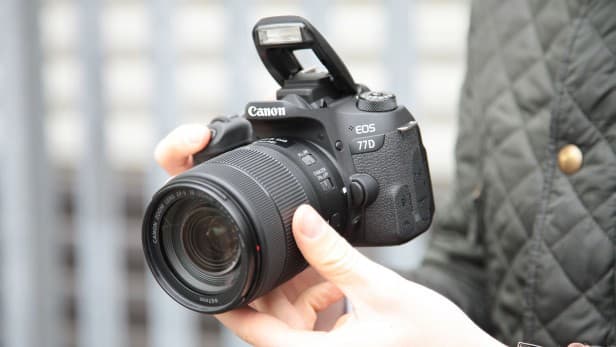
In addition to these speed benefits, the new sensor and processor pairing also allows the EOS 77D to shoot at a higher maximum native sensitivity setting of ISO 25,600 (along with the equivalent of ISO 51,200 in expanded mode). By comparison, the 750D/760D both offer a maximum native sensitivity setting of ISO 12,800, with the equivalent of ISO 25,600 available in its expanded mode.
The EOS 77D’s new AF system is a far cry from the 19-point autofocus system that featured on the EOS 760D. The major revamp has seen it inherit the same 45-point all-cross-type AF system from the EOS 80D. Out of the 45 AF points on offer, 27 remain active when using a teleconverter and lens combination with a maximum aperture of f/8, whereas the centre point is sensitive down to f/2.8.
The good news doesn’t end here. The working range of the AF system also spans wider than it did before, and operates across a -3EV to 18EV range.
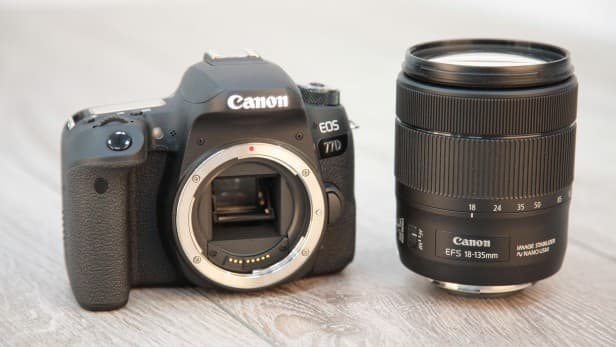
At this point, you might be wondering how the EOS 77D differs from the EOS 80D. Viewing the EOS 77D from above reveals that its top-plate LCD is smaller and more cramped.
Turning to the rear, the pentamirror viewfinder, with its 95% coverage of the frame and 0.82x magnification, doesn’t quite trump the 100% frame coverage and 0.9x magnification of the EOS 80D’s pentaprism. Neither does its battery offer the same stamina.
Whereas the EOS 80D can shoot 960 shots on a single charge, the EOS 77D’s smaller LP-E17 battery lasts for about 600 shots.
There are other differences, too, with the 80D shooting a continuous burst 1fps faster and presenting a higher maximum shutter speed (1/8000sec as opposed to the EOS 77D’s 1/4000sec).
Below the EOS 77D’s viewfinder you get a 3in, 1.04-million-dot, vari-angle touchscreen, with metering left in the capable hands of Canon’s 7,560-pixel RGB IR metering sensor – yet another feature it inherits from the EOS 80D.
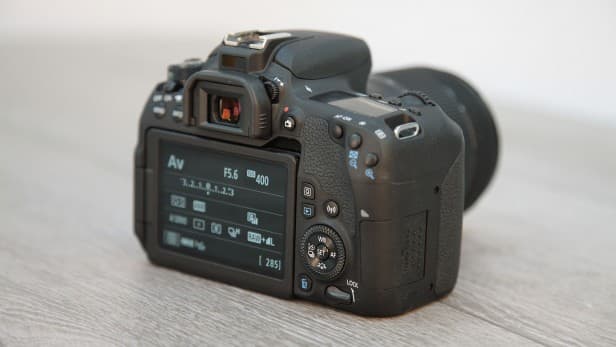
The EOS 77D doesn’t feature 4K video, but provides videographers with the option of shooting Full HD (1920×1080) movies up to 60p in the MP4 format. By way of comparison, the highest video setting on the 760D is 1080p Full HD at 30fps.
Even more impressive is the EOS 77D’s introduction of in-camera electronic image stabilisation. This is applicable only to movie recording and cannot be used for still-image capture, but it can be activated to ensure smoother video capture when shooting handheld.
Just like the EOS 800D, the EOS 77D sports a 3.5mm microphone port in addition to the twin stereo microphones either side of the pop-up flash. However, you’ll want to look at the EOS 80D if a headphone socket to monitor audio is a priority.
To satisfy those who would like to control the camera wirelessly and share images via a mobile device, the EOS 77D is Wi-Fi and NFC equipped. The camera’s wireless connectivity teams up with Canon’s Camera Connect app that’s free to download via the App Store for iOS devices or Google Play for Android.
In addition, the camera offers constant Bluetooth wireless control, which ties in with a new BR-E1 remote controller (£39) that can fire the shutter with no line of sight from 5m away.
Canon EOS 77D – Build and design
Whereas the EOS 800D falls into Canon’s DSLRs for beginners range, the EOS 77D positions itself in the manufacturer’s DSLRs for enthusiasts line-up.

The overall build quality feels more or less in keeping with the EOS 80D, and the aluminium-alloy chassis and polycarbonate resin with glass-fibre finish combine well to give it reassuringly strong feel in the hand. All the body panels are made to a high standard and there are no creaking noises when the body is held tightly in your right hand, as you occasionally get on some cheaper entry-level DSLRs.
Although the EOS 77D is well constructed, it’s important to note that it’s similar to the EOS 800D in that it doesn’t offer weather sealing. If you know that you regularly shoot in inclement weather or want the extra peace of mind that comes with owning a camera with weather seals, the EOS 80D would be the more suitable mid-range option.
Unlike the EOS 800D, which has a simplified layout of controls to enhance its appeal with first-time and novice DSLR users, the EOS 77D has a somewhat busier look to its body, with a greater number of buttons and dials.
One of the key differences is the rotating thumb wheel at the rear, which takes the place of the EOS 800D’s four-way directional pad. This provides fast, independent control of aperture in manual mode – something that’s not as easy on the EOS 800D, which requires you to hold the AV/exposure-compensation button at the same time as using the single command dial on the top-plate.
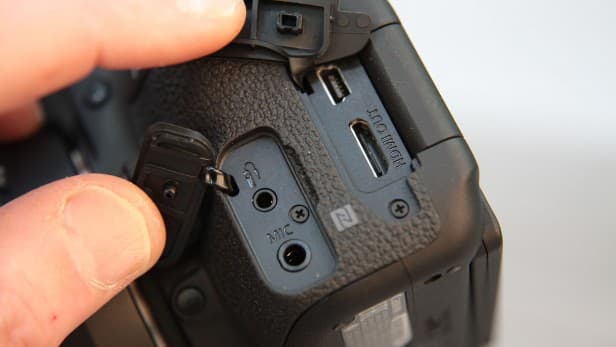
In addition, the rear thumb wheel on the EOS 77D doubles up as a quick way of adjusting exposure compensation in program, aperture-priority and shutter-priority modes. The only drawback from an operational perspective is that it’s like the dial you get on the EOS 760D – it’s rather small and doesn’t offer the same resistance as the rear dials on more expensive enthusiast DSLRs such as the EOS 7D Mark II.
Although the EOS 77D’s handgrip isn’t the largest, it happily accommodates average-sized hands and lets you grip the body without feeling as if your little finger is about to drop off the end. The rubberised grip doesn’t wrap all the way around the side of the body so your palm does come into contact with plastic, and at the rear you get a comfortable thumb rest, which, as on the front of the grip, is rubberised.
The AF-ON button, like the top-plate LCD panel, will appeal to more experienced users, and it can be used to separate autofocus activation from the shutter release, and perform back-button focusing, which isn’t possible on the EOS 800D.
Canon has again carved out a small section of the body below the mode dial to accommodate the camera’s on/off switch. Centralising the switch turns the camera on, whereas flicking it all the way to the right engages video mode. This is different to the EOS 800D, which lets you to turn the camera on, control the shooting modes and drive it from your right hand, with the exception of the main menu and info buttons.
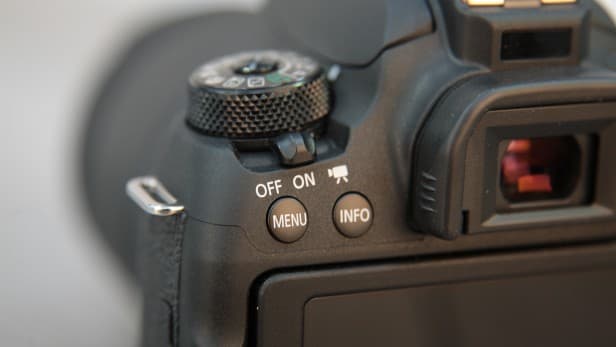
Those familiar with the EOS 760D will notice that the EOS 77D inherits the eye sensor above the viewfinder. Its purpose is to turn off the info screen or electronic-level function when the camera is raised to the eye, to preserve battery life. You may also notice the presence of a lock switch, which isn’t on the EOS 800D, that prevents the EOS 77D’s rear scroll dial being accidentally adjusted.
The rear screens on Canon’s latest DSLRs are well known for being excellent and the EOS 77D’s is no exception. There’s an indent just below the live view button that allows it to be pulled out from the body by 180°. From this position it offers 270° of rotation to aid low and high-angle shooting. It’s super-responsive to light touches and lets you navigate the main menu, quick menu and plethora of on-screen live view settings with no difficulty or fuss.
This review was originally published on Trusted Reviews
Canon EOS 77D – Autofocus
The significant benefit you gain from choosing the EOS 77D ahead of the outgoing but still available EOS 760D is an enhanced focusing performance in live view mode and when you’re recording HD video. You no longer get any annoying stuttering as the camera attempts to acquire accurate focus in live view and you can employ continuous autofocus (AI servo), too – a feature that first appeared on the EOS 80D.
While most users will use one-shot AF when photographing stationary subjects in live view, those who like to shoot moving subjects and want the camera to track its movement will select servo AF with the live tracking AF method.
After testing, I found the camera’s tracking AF method works adequately for subjects that don’t move erratically, but I achieved more consistent results with fast-moving subjects by tracking the subject in the centre of the frame with the AF method set to zone AF.

The EOS 77D’s spread of 45 autofocus points across the frame is also superior to the EOS 760D’s arrangement of 19 AF points. The AF points can be highlighted in the viewfinder or on the screen at any time using the AF point selection button on the shoulder of the body or by using the AF area button beside the ISO button on the top-plate.
The layout is made up of three groups of 15 points, with the central group being spread slightly wider and higher than the two groups either side.
Just as with the EOS 800D, there is a sizeable gap around the edge of the frame that isn’t covered by any AF points and you don’t get the option to reduce the number of selectable points as you do on more advanced models such as the EOS 7D Mark II. This means that it’s not the fastest camera to use when it comes to shifting the AF point around the frame quickly.
This point aside, the EOS 77D focused quickly and accurately with the EF-S 18-135mm f/3.5-5.6 IS USM kit zoom that was supplied with our review camera (available as part of a kit for £1199) as well as with more expensive L-series optics.
Canon EOS 77D – Burst shooting
Photographing a variety of subjects from fast cars to a game of cricket revealed that the EOS 77D rattles out JPEGs for as long as the shutter is depressed.

Switching the file format to RAW saw the camera record 22 consecutive images to my 32GB Lexar Professional Class 10/U3 SDHC card – a few frames short of what Canon claims is possible, but still a significant improvement over the EOS 760D.
Canon EOS 77D – Wi-Fi connectivity
Once it’s set up, the connection process between camera and mobile devices using Wi-Fi is quick and easy, thanks to the dedicated connectivity button at the rear of the camera. The Camera Connect app provides all the options you need to take remote control from an iOS or Android device, and you get the option to down-sample images to a more friendly size for emailing and sharing, too.
Canon EOS 77D – Performance
Set to its default ‘standard’ picture style, you’ll get impressive results straight out of the camera, with rich colour and a high level of contrast. Users can experiment with the various picture styles, but if you’re after results that aren’t quite as vibrant, the neutral or faithful picture styles may be preferred.

Metering from the 7560-pixel RGB+IR metering sensor produces consistent and accurate exposures in all but the most extreme high-contrast situations, resulting in evenly lit images that are neither too dark nor too bright. Likewise, automatic white balance can generally be relied upon to render accurate colour consistently.
Canon EOS 77D – Dual Pixel AF
Canon’s Dual Pixel CMOS AF technology made its debut on the EOS 70D back in 2013. Since then, we’ve seen it introduced in no fewer than seven DSLRs, which include the EOS 80D and EOS 800D. In practical terms, the main benefit of Dual Pixel CMOS AF is that it greatly speeds up focus-acquisition times when the camera is being operated in live-view mode.
The way it basically works is that each pixel on the sensor’s surface is split into two individual photodiodes – one left and one right. Each of these can be read separately, thereby allowing faster phase-detection autofocus while simultaneously being used for image capture.
Prior to the introduction of Dual Pixel CMOS AF, Canon DSLRs relied on contrast-detect technology, which is typically slower and less accurate at locking on to targets than phase detection – noticeably so when attempting to focus on a moving subject.
The EOS 77D sports the manufacturer’s fastest on-sensor phase-detection technology currently available, which includes support of Servo AF. This allows the user to select focus on a subject and track it through the frame, when all the while the shutter button is half depressed.
It’s particularly effective for capturing sharp shots of moving subjects, and our best results were achieved when we switched the AF method from single-point AF to Zone AF. It’s great to see this technology trickling down to DSLRs at the EOS 77D and EOS 800D’s price point and you sense it’s only a matter of time before it reaches entry-level EOS models.
Canon EOS 77D – Image Quality
Resolution
Whereas some of its rivals, such as the Nikon D5600 and Pentax KP, go without an anti-aliasing filter in an effort to resolve the finest detail, the EOS 77D holds on to an anti-aliasing filter. With this in place, it has its work cut out to achieve the same levels of resolution.
At ISO 100, the sensor resolves a level of detail that we’d expect from an APS-C DSLR with an anti-aliasing filter. Our dynamic-range tests show an improvement on the 750D/760D, with the EOS 77D returning figures that are higher across the entire sensitivity range.

Canon EOS 77D, RAW, ISO 100. Multiply the number below the line by 200 for the resolution in lines/picture height

Canon EOS 77D, RAW, ISO 3200. Multiply the number below the line by 200 for the resolution in lines/picture height

Canon EOS 77D, RAW, ISO 25,600. Multiply the number below the line by 200 for the resolution in lines/picture height

Canon EOS 77D, RAW, ISO 51,200. Multiply the number below the line by 200 for the resolution in lines/picture height
Dynamic range
Compared to the EOS 760D, which delivered a figure of 11.6EV at ISO 100, the EOS 77D produces a higher 12.5EV figure at its base sensitivity setting. The dynamic range is higher throughout the sensitivity range, although it can’t quite match the readout we recently recorded by the Pentax KP, which achieved figures above 10EV right up to ISO 3200. Beyond ISO 800, the EOS 77D’s dynamic range drops to 9.3EV at ISO 1600, 8.4EV at ISO 3200 and 7.5EV at ISO 6400.
The 6EV figures that are recorded between ISO 12,800 and ISO 51,200 indicate that shadow detail becomes more heavily affected by noise beyond ISO 6400.

Noise
As with resolution, you’ll achieve better results by processing raw files yourself than shooting in the JPEG format and relying on the in-camera JPEG processing to remove noise for you.
Shoot in the raw format and you’ll notice that noise does start to make its presence known in files captured at ISO 800, but with vigilant application of noise reduction in post-processing, you can get usable results out of the camera at settings as high as ISO 3200 and ISO 6400.
Chroma noise is handled well throughout the sensitivity range, but you’ll notice that saturation does begin to take a hit at ISO 12,800 and above. With this in mind, you’re best off avoiding the five-digit ISO settings wherever possible and keep ISO 6400 set as the maximum ISO when you’re using the camera in its auto ISO mode.

Canon EOS 77D, RAW, ISO 50

Canon EOS 77D, RAW, ISO 6400

Canon EOS 77D, RAW, ISO 12,800

Canon EOS 77D, RAW, ISO 25,600
Should I buy the Canon EOS 77D?
The Canon EOS 77D has a lot in common with the EOS 800D when it comes to its core specification. Study the pair side by side and their differences start to become more obvious. The rotating thumb wheel at the rear, dedicated AF-ON button, LCD screen on the top plate and automatic eye sensor are factors that suggest the EOS 77D will appeal to more advanced photographers who are possibly looking for finer control than you’d get from an entry-level model. That said, it’s well geared up for newcomers to a DSLR, too.
Inside the menu you’ll find the same optional guided interface that you get on the EOS 800D, which, when activated, changes the shooting screen and menu display on the LCD to a more animated one that provides information and practical advice specific to the exposure mode selected. The information doesn’t go into any great detail, but should nonetheless prove useful to those users starting their DSLR journey.

If you’re just starting out in the world of DSLR photography, you’ll feel at ease with the EOS 800D as soon as you get it out of the box. What you don’t want, though, is to regret your decision and wish you’d chosen the EOS 77D instead. If you’re undecided about which to buy, ask yourself these two questions: Am I a quick learner? Am I going to pursue photography regularly? If your answer is yes to both, the extra £50 you’ll pay for the EOS 77D will get you a camera that’ll serve you better in the long term.
The EOS 77D is a capable DSLR for aspiring enthusiasts and those starting out. It’s more expensive than its main rivals, but offers a much-improved live-view performance over the EOS 760D it replaces, performs well in low light up to ISO 6400, and it operates intuitively, making it a very enjoyable camera to use.
Find more great Canon DSLRs in our guide to the best Canon EOS DSLRs you can buy!

